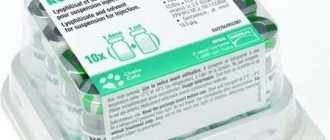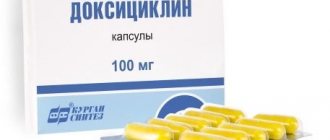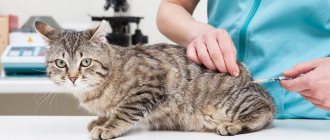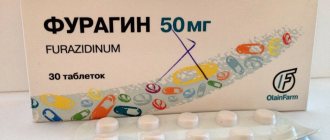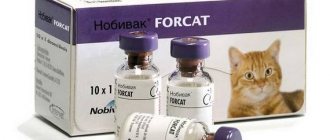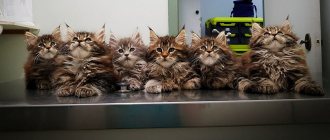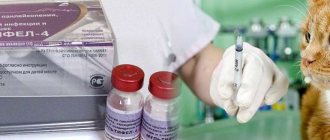A viral disease that can lead to the death of a pet is rabies. An effective way to combat the disease is vaccination, regardless of whether the pet is constantly in the apartment or in contact with street animals. Veterinarians recommend a universal medicine - Rabizin for cats and dogs. Vaccination is a reasonable method of prevention for any four-legged human friends.
General information about the drug
Rabizin is an effective remedy aimed at combating rabies in cats and dogs of all breeds. If the recommended use regimen is followed, the injection can protect your pet from serious illness. The development of the vaccine was carried out by a French company specializing in the production of medicines for pets and livestock.
Rabizin for dogs and cats is a colorless liquid substance with slight turbidity. During long-term storage, sediment forms at the bottom of the container. This is a normal phenomenon; after shaking the bottle, the sediment dissolves.
The medicine is packaged in glass bottles, closed with a rubber stopper, on top of which is an aluminum cap for additional protection. One container with the drug contains from 10 to 100 containers. In veterinary pharmacies the product is sold individually. One immune dose corresponds to 1 ml of the substance.
Proper storage during transportation and in the warehouse implies compliance with the recommended temperature range of 2−8 °C above zero. If the liquid is frozen, it will completely lose its pharmacological properties. Also, exposure to direct sunlight is unacceptable. At home, it is recommended to keep the drug in the refrigerator (vegetable compartment), without direct contact with food.
general description
Rabizin is a colorless liquid. Outwardly it is a little cloudy. If left motionless for a long time, sediment may form at the bottom. Such a phenomenon is not considered a deviation from the norm if the sediment disappears when shaking.
Glass bottles are used for packaging. They are sealed with rubber stoppers and then rolled up with aluminum lids. The vials are then packaged into containers of 10 or 100, but pharmacies sell them individually rather than in packs. Each container contains 1 ml of liquid, which is equal to one immune dose.
The product contains inactivated (non-living) cells infected with the rabies virus, however, during storage and transportation it is important to maintain a temperature range of 2 to 8˚C. Freezing the solution is strictly prohibited, as it will lose its properties. It should not be exposed to sunlight. It is best to store the medicine in the refrigerator, on a separate shelf so that it does not come into contact with food.
Features of the vaccine action
The vaccine consists of non-living cells infected with rabies. Intramuscular administration of Rabizin to an animal helps to form stable immunity against the virus. Considering that the cells contained in the drug are dead, it is safe for cats and dogs if the rules recommended by the manufacturer are followed.
For the normal formation of immune defense in an animal, a two-fold application regimen is used. Depending on the individual characteristics of the pet, protection is formed within 2-3 weeks. The period depends on immunity, the general condition of the animal and side factors. The medicine is effective for a year, after which revaccination is carried out. The drug is not therapeutic and is used purely for preventive purposes.
Any vaccinations, including rabies, are not a 100% guarantee that an animal will not become infected with the virus. However, they help minimize risks.
Recommendations from veterinarians before vaccination
Vaccinating cats against rabies requires following the basic rules:
- Two weeks before visiting the veterinary clinic, the cat must be dewormed.
- Vaccinations for weakened or sick animals are prescribed only by a veterinarian. Before administering the vaccine, a specialist examines the animal and takes clinical tests.
- Vaccination of pets is prohibited during the postoperative or post-traumatic periods, or while taking antibiotics.
- Animals suffering from allergic reactions or having undergone a long course of treatment with corticosteroid drugs, or with poor immunity, are prescribed a rabies vaccination together with immunomodulators.
After the intramuscular injection, the attending physician enters a note on rabies vaccination into the veterinary passport and confirms it with a wet stamp and signature.
Features of application
The drug is administered subcutaneously or intramuscularly. Rabizin, instructions for use of which are included with the injections, is used for cats as a prophylaxis against the rabies virus. The first vaccine is given to animals over 3 months of age. Immunization is repeated annually. It is not recommended to revaccinate less than once a year. This significantly increases the risk of the animal becoming infected with the virus.
Veterinarians administer the drug to cats and dogs subcutaneously. This method of vaccination is easier to tolerate by animals than intramuscular injection. The drug is injected with a syringe into the area between the shoulder blades. The dose is prescribed by a veterinarian at the rate of 1 ml of liquid per 1 animal, regardless of age or weight. Rabies vaccination requires compliance with the following rules:
- Before use, the bottle with the contents is shaken until the sediment formed at the bottom during storage is completely dissolved.
- The injection is given with a disposable sterile syringe and needle. In order not to traumatize the cat’s psyche, it is better to use an insulin syringe with a thin needle. When vaccinating, washing must be kept clean.
- When injecting multiple pets, an individual syringe is used for each animal.
Sometimes your veterinarian may prescribe the use of a rabies drug and a calcevirus vaccine together. This may be chlamydia, panleukopenia and infectious rhinotracheitis. If an allergic reaction is possible, antihistamine therapy is administered before vaccination. The drug and dosage are determined individually by the doctor.
Rabizin's vaccine is contraindicated in combination with immunobiological-based drugs. Rabies vaccination requires quarantine for your pet. Contact with other domestic or street animals is undesirable for 21 days.
Vaccine Rabizin
Vaccine Rabizin for the prevention of rabies in animals
General information
Trade name: Rabisin.
International nonproprietary name: Vaccine for the prevention of rabies in animals. Dosage form: suspension for injection.
The Rabizin vaccine is made from the culture liquid of the NIL2 cell line infected with the rabies virus (strain G-52), inactivated by betapropiolactone, with the addition of aluminum hydroxide - 1.7 mg, physiological solution - up to 1 ml. In appearance, the vaccine is a colorless opalescent liquid. During storage, a slight sediment may form, which easily breaks up when shaken into a homogeneous suspension. The Rabizin vaccine is packaged in 1 ml (1 immunizing dose) in glass vials of appropriate capacity, hermetically sealed with rubber stoppers reinforced with aluminum caps. Vials of the vaccine are packaged in boxes of 100 or 10 pieces. Each box of vaccine contains instructions for its use.
Biological properties
The Rabizin vaccine causes the formation of an immune response to the rabies virus 14-21 days after administration, lasting up to 36 months. One immunizing dose (1 ml) contains at least 1 IU of rabies virus (strain G-52). The vaccine is harmless and has no medicinal properties.
Application procedure
The Rabizin vaccine is intended for cats, dogs, ferrets, horses, cattle and sheep to prevent rabies. It is allowed to vaccinate pregnant and lactating animals.
It is prohibited to vaccinate clinically sick and/or weakened animals. 10 days before vaccination it is necessary to carry out deworming.
The vaccine is administered subcutaneously in the area of the shoulder blade or intramuscularly; for horses - only intramuscularly, in a dose of 1 ml, regardless of the weight and type of animal.
Primary vaccination with Rabizin is carried out:
for dogs and cats - twice, the first injection at the age of no earlier than 3 months, then after 12 months; for ferrets - once at the age of no earlier than 3 months; for horses, cattle and sheep - once at the age of no earlier than 4 months. Revaccination is carried out annually.
Shake the vaccine bottle before vaccination. When vaccinating, it is necessary to follow the rules of asepsis and antiseptics.
There are no symptoms of rabies or other pathological signs associated with an overdose of the vaccine. Features of the post-vaccination reaction during primary and repeated immunizations have not been established.
Violations of the vaccination schedule should be avoided, as this may lead to a decrease in the effectiveness of rabies immunoprophylaxis. If the next dose of vaccine is missed, immunization should be carried out as soon as possible.
Contraindications
When using the vaccine in accordance with these instructions, there are usually no side effects or complications. A quickly disappearing swelling may sometimes appear at the injection site. In exceptional cases, an anaphylactic reaction is possible. In this case, symptomatic treatment is carried out.
The simultaneous use of the Rabizin vaccine with other immunobiological drugs is not allowed, with the exception of vaccines against panleukopenia, infectious rhinotracheitis, calicivirus infection and feline chlamydia (Purevax RCP, Purevax RCPCh) and the vaccine against feline viral leukemia (Purevax FeLV) produced subject to their separate administration. It is not recommended to mix in one syringe.
Storage conditions
The vaccine is stored and transported in a dry, dark place at a temperature of 2°C to 8°C. Freezing of the vaccine is not allowed.
The shelf life of the vaccine is 36 months from the date of release, subject to storage and transportation conditions. After the expiration date, the vaccine is not suitable for use.
The vaccine should be stored out of the reach of children.
Vials with a vaccine without labels, with an expired expiration date, with a violation of the integrity and/or tightness of the closure, with the presence of foreign impurities, frozen, not used within 3 hours after opening, are subject to rejection and disinfection by boiling for 30 minutes, followed by disposal. Disposal of decontaminated vaccine does not require special precautions.
Personal prevention measures
When working with the vaccine, you should follow the general rules of personal hygiene and safety precautions provided for when working with veterinary medicinal products. When finished, wash your hands with warm water and soap. All persons participating in vaccination must wear special clothing and be provided with personal protective equipment. Places of work must have a first aid kit. If the vaccine gets on the skin and/or mucous membranes, it is recommended to rinse them with plenty of tap water. If the drug is accidentally administered to a person, the injection site must be treated with a 70% ethyl alcohol solution, contact a medical facility and inform the doctor about this.
Organization-, 29 av. Topu Gamier, 69007, Lyon, France. Manufacture address: Merial, Laboratoire Porte des Alpes, 69800 Saint Priest, France. The instructions were developed by the company developed (France) and the Merial Business Unit (Moscow).
With the approval of this instruction, the instructions for the use of the Rabizin vaccine, approved by the Deputy Head of Rosselkhoznadzor on October 19, 2011, become invalid.
Keeping the animal after vaccination
For 2-5 days after administration of the drug, the cat may experience drowsiness and lethargy. Veterinarians recommend avoiding stressful situations and unnecessary physical activity for the animal during this period. Therefore, it is better to avoid traveling and changing your pet’s usual living environment.
Immune protection against rabies after injection of Rabizin is formed within 2-3 weeks. The cat must be in quarantine for the entire period. Contact with pets that have not received a vaccine against the virus is prohibited.
Vaccination statistics have not revealed cases of drug overdose. Sometimes animals experience a local allergy, which manifests itself as swelling in the area of the injection. If the problem persists for a long time, the doctor prescribes treatment in accordance with the identified symptoms.
Any surgical intervention, including castration, can be carried out no earlier than 30 days after vaccination. Vaccination against rabies is contraindicated in kittens during the period of replacement of baby teeth with molars.
If you strictly follow the instructions for using the medicine and the rules of vaccination, Rabizin for cats does not cause side effects. It creates lasting immunity to rabies.
Restrictions on use
Rabizin injections are prescribed to completely healthy animals. Vaccinations for sick and severely weakened pets are strictly contraindicated. First, symptomatic treatment is carried out for existing pathologies and only then an injection for rabies.
The drug is approved for use in pregnant cats and during lactation.
The drug is prescribed to kittens from 3 months of life. The use of the medicine in combination with other drugs is possible only as prescribed by a veterinarian. It is acceptable to use Rabizin together with Purevax if the animal has chlamydia, rhinotracheitis, panleukopenia or calcivirus. Funds are entered separately. You cannot mix drugs of different compositions in one syringe.
If an eight-year-old or older cat has never been vaccinated against rabies or other infectious diseases, a comprehensive examination and tests must be carried out before using Rabizin. It is advisable to call a doctor at home to prevent contact with sick animals.
Important nuances
In some cases, Rabizin cannot be used for cats and other animals, in particular if storage rules have been violated. You should stop using it in the following cases:
- The bottle does not contain any information about the manufacturer, production time, composition, etc. There is no label.
- The color or consistency of the solution has changed.
- Foreign impurities have appeared in the liquid (for example, in the form of flakes), which do not “break up” when shaken.
- The seal of the packaging was previously broken.
Side effects after the injection
Subject to the conditions of storage and use of the drug, the animal easily tolerates vaccination without side effects. In most cases, the cat will not show signs of rabies, lethargy, or decreased appetite.
A common problem is the formation of swelling in the injection area. It does not require outside intervention and goes away on its own over time. In rare situations, as indicated in the instructions for the drug, anaphylactic shock may occur. Then urgent first aid is required. An effective allergy drug is usually administered to block the adverse reaction. The problem is relevant during the first vaccination, when the animal’s reaction is unknown.
How much does a dose of the drug cost and how easy is it to find?
Rabisin is sold freely in veterinary pharmacies, online stores and private clinics. On average, a dose sufficient for 1 time costs from 120 to 170 rubles, depending on the region.
Despite the free sale and easy availability, veterinarians advise that before purchasing, consult your clinic about places you can trust and not order anything from stores located in other cities. Since it is imported, you cannot always be sure that the storage and transportation conditions were correct.
Composition and release form. The "Rabizin" vaccine is a liquid inactivated aluminum hydroxide vaccine of a fixed rabies virus, strain GS-57 WISTAR.
Additional precautions
Rabisin injection is a safe drug that does not contain living cells infected with rabies. When using the product, no special precautions are required; compliance with the rules for the use of veterinary drugs is sufficient.
If the drug gets on open areas of the skin or mucous membrane of the eye, it is enough to rinse the affected area under a stream of clean water. In case of unintentional injection of a person, the site is treated with an alcohol solution and you should immediately consult a doctor.
Reviews
Owners
Ekaterina, Nizhny Novgorod : “When our dog was 3 months old, we went to the veterinary clinic for vaccination against rabies. The veterinarian gave an injection of Rabizin. The dog felt well, there were no complications.
A year later we went for vaccination again. And again the doctor used the same drug. But this time the dog did not feel so good after the vaccination: she was lethargic, slept a lot, and refused to eat. I don't know what this is connected with. And the vet couldn’t really explain anything. Next time I’ll ask you to change the vaccine.”
Leonid, Rostov-on-Don : “Every year I take my dog for a rabies vaccination. The veterinary clinic constantly used the same drug, which was written about in the dog’s veterinary passport. But this time he was not there, so the veterinarian suggested Rabizin, saying that he was no worse.
After vaccination we returned home. The dog behaved as usual: he ate well, played, and then slept peacefully. I concluded that this drug can also be injected. The main thing is that the pet does not get sick.”
Evgeniya, Vladivostok : “Every year we vaccinate our toy against rabies. I have never chosen a drug because I completely trust doctors. But the previous time, the dog did not tolerate the vaccine well, which is what she told the veterinarian about. He advised Rabizin and said that there were almost no complaints about side effects.
His words were confirmed. After vaccination we returned home. No changes in the dog's behavior were noticed. He was just as active, ate well, and fell asleep in the evening without complaining about anything. It’s a good vaccine, but I don’t recommend injecting yourself.”
Veterinarians
Sergey, veterinarian, Irkutsk : “I consider Rabizin one of the best vaccines against rabies. When used correctly, the product does not cause side effects. The vaccine is sold at an affordable price, which is a plus.”
Zinaida, veterinarian, Novosibirsk : “I often use Rabizin to prevent rabies. The vaccine is effective and has few contraindications. Puppies older than 3 months can be vaccinated.”
Cost and substitutes
The drug is available in veterinary pharmacies at a price of 120 rubles. in one shot. Rabizin injections are a prophylactic agent widely used by veterinarians.
Alternatively, the following may be prescribed:
- Nobivac;
- Eurican.
The drug has a combined effect and, in addition to protecting against rabies, produces immune protection against acute viral infections.
The medicine is available at any veterinary pharmacy, as well as in online stores. In the latter case, there is a danger of purchasing a drug that was stored without complying with the appropriate conditions. When agreeing to remote purchases, it is important to cooperate with trusted stores. Otherwise there may be a risk to the animal.
Price
The price of one bottle of Rabizin ranges from 140-160 rubles. At a veterinary pharmacy you can buy the required number of bottles depending on the number of pets that live in your home. The product is sold in regular veterinary pharmacies and on the Internet. If you prefer the second option, the product will cost less, but in this case there is a risk of buying a medicine that was stored incorrectly. If you decide to buy a drug on the Internet, do it in trusted pharmacies so as not to risk your pet’s health.
You can now view the current price of the drug and buy it right here:


